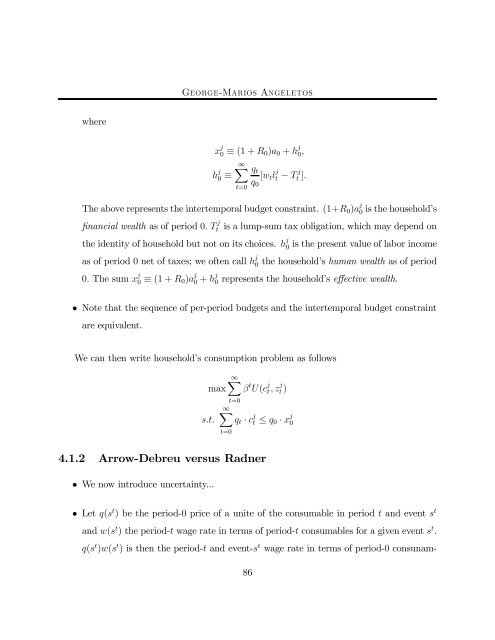14.451 Lecture Notes Economic Growth
14.451 Lecture Notes Economic Growth
14.451 Lecture Notes Economic Growth
Create successful ePaper yourself
Turn your PDF publications into a flip-book with our unique Google optimized e-Paper software.
where<br />
George-Marios Angeletos<br />
x j<br />
0 ≡ (1 + R0)a0 + h j<br />
∞X<br />
h j<br />
0 ≡<br />
t=0<br />
qt<br />
q0<br />
0,<br />
[wtl j<br />
t − T j<br />
t ].<br />
The above represents the intertemporal budget constraint. (1+R0)a j<br />
0 is the household’s<br />
financial wealth as of period 0. T j<br />
t is a lump-sum tax obligation, which may depend on<br />
the identity of household but not on its choices. h j<br />
0 is the present value of labor income<br />
as of period 0 net of taxes; we often call h j<br />
0 the household’s human wealth as of period<br />
0. The sum x j<br />
0 ≡ (1 + R0)a j<br />
0 + h j<br />
0 represents the household’s effective wealth.<br />
• Note that the sequence of per-period budgets and the intertemporal budget constraint<br />
are equivalent.<br />
We can then write household’s consumption problem as follows<br />
s.t.<br />
max<br />
∞X<br />
t=0<br />
∞X<br />
t=0<br />
β t U(c j<br />
t,z j<br />
t )<br />
qt · c j<br />
t ≤ q0 · x j<br />
0<br />
4.1.2 Arrow-Debreu versus Radner<br />
• We now introduce uncertainty...<br />
• Let q(s t ) be the period-0 price of a unite of the consumable in period t and event s t<br />
and w(s t ) the period-t wage rate in terms of period-t consumables for a given event s t .<br />
q(s t )w(s t ) is then the period-t and event-s t wage rate in terms of period-0 consunam-<br />
86

















